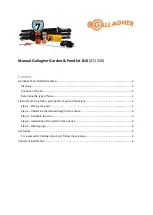
4-23
4.2.2 The basics of locating lines with the receiver
4.2.2.1 Modes of operation for the receiver
Basics of passive line
location
If a
Easyloc Tx
transmitter is not available, a site can also be probed by means of
passive line location.
The Easyloc Rx
receiver is capable of detecting radio signals in the frequency range
between 15 kHz to 23 kHz as well as power signals in the frequency range between
50 / 60 Hz.
The following pictures illustrate how each of the signals couple onto conductors buried
in the ground:
Modes of operation for
the receiver
The two options explained above for passive location together with the options of
active location with a transmitter or a probe transmitting a signal with an
appropriate frequency result in the following modes of operation:
Symbol
Mode of operation
RADIO
For locating cables which are carrying VLF reradiated radio signals.
(not available for
Easyloc CAM
)
POWER GRID
For locating mains power supply cables, through which current with a
grid frequency is flowing.
TRANSMITTER
For locating cables or pipes, onto which the signal from an active
transmitter is coupled. The figure indicates the currently selected
frequency which has to correspond to the frequency of the transmitter.
PROBE
For locating a probe, pig transmitter or camera probe. The figure
indicates the currently selected frequency which has to correspond to
the frequency of the probe.
www.calcert.com
1.800.544.2843
0
5
10
15
20
25
30












































